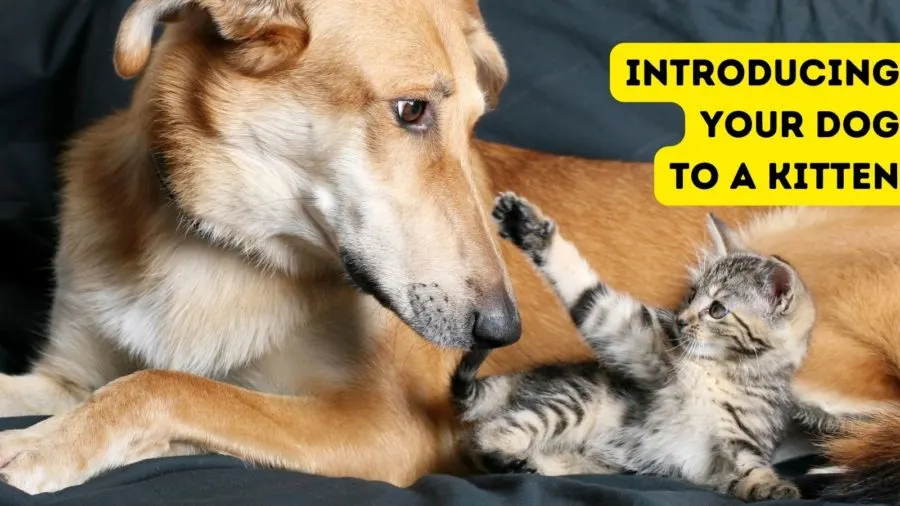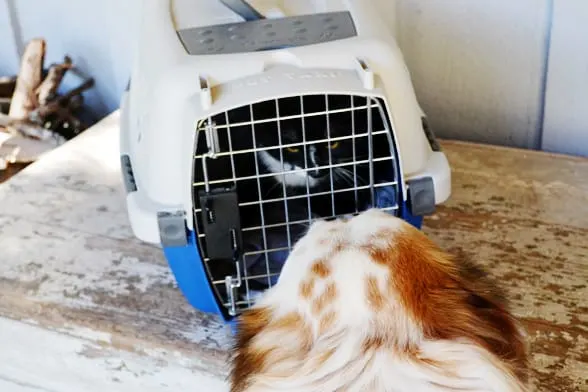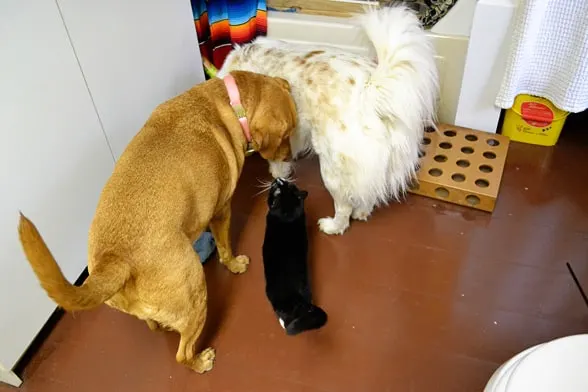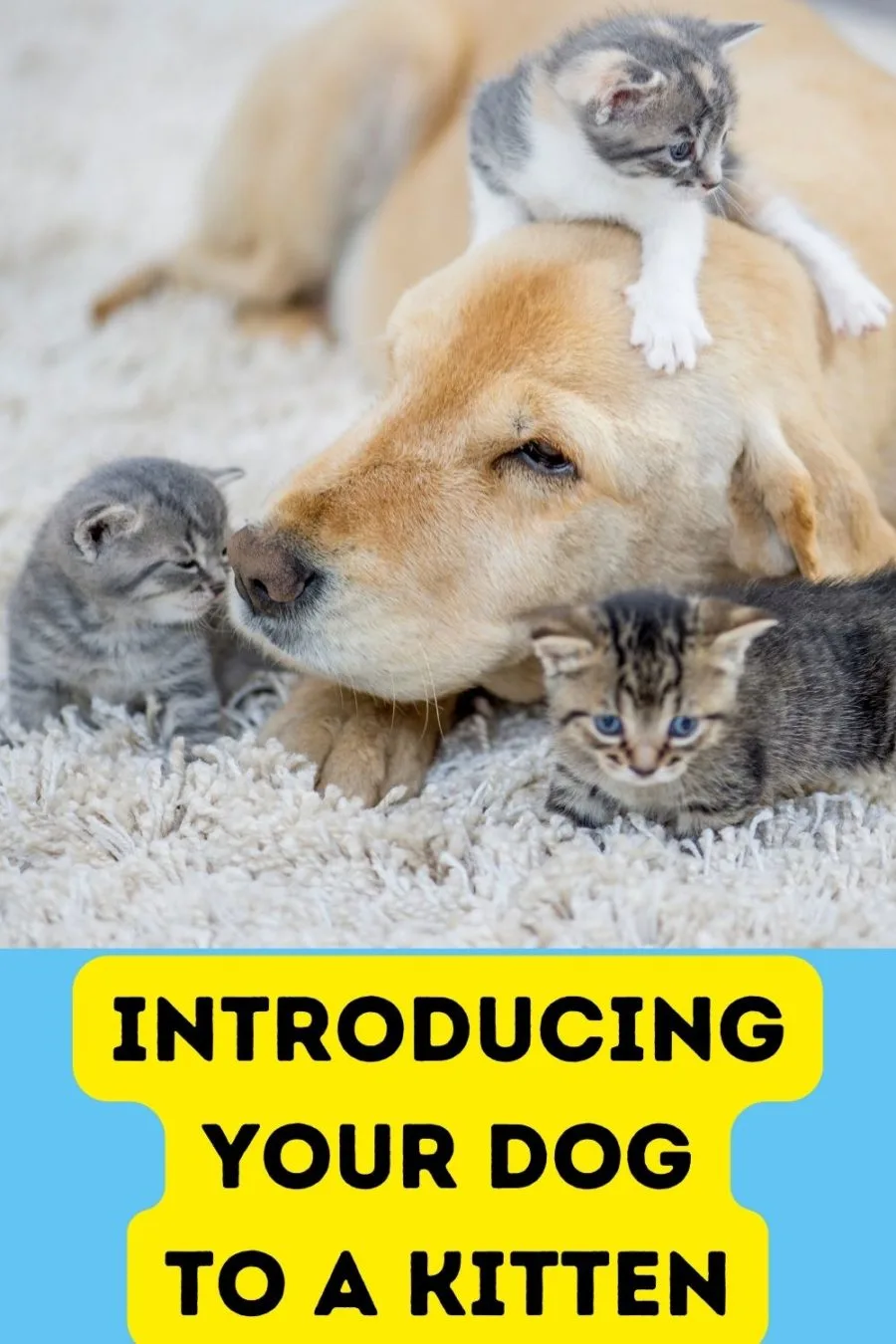Have you recently adopted a kitten and need to introduce your dog? Through the years, we’ve introduced our dogs to many new kittens–and it’s definitely a process you’ll want to take slowly and carefully.
Many pet lovers don’t identify themselves solely as dog OR cat people but would like to share their home with both. What holds some people back is the fear of disaster. And while a new cat or kitten can certainly attack a dog (with the real risk of serious eye injury), the biggest worry is generally of the dog attacking the kitten. You want to make this introduction of dog and kitten little by little with a plan in place. We’ve got some tips for you!

Our Experience Introducing Our Dogs to a New Kitten
Our house has always been a “bipetual” home with more than one dog and more than one cat. Unlike the stereotype of dogs versus cats or “fighting like cats and dogs,” our dogs and cats have always shared a happy home. They create one big family for us all, sharing everything from water fountains to the bed.

If you’re bringing a new puppy into a home with a resident cat, you have the advantage. The resident cat has the upper paw in terms of territory, size, and knowing the lay of the land. The puppy will be submissive in most cases to the resident cat.
But this post is about introducing your resident dog to a new cat or kitten, an experience we had just this week with the adoption of little four-month-old Lucky. Weighing in at five pounds, Lucky was entering the home of 60-pound Tiki and 65-pound Irie.
Choosing a Kitten
One reason we selected a four-month-old kitten rather than a two-month-old kitty was the dogs. A four-month-old is far less fragile and much better equipped to jump up on a table or counter and out of the dogs’ way than an eight-week-old kitten. (That said, years ago we adopted a four-WEEK-old kitten who charmed her way right into our dogs’ hearts.)
And while we fell in love with Lucky from his photo on the Austin Pets Alive! website, we held off making the decision until we met him in person.
Because of the dogs, we wanted an outgoing kitten who wasn’t shy. Lucky was all that and more.
Creating a Safe Room
Your new kitten needs a safe place to adjust and decompress upon arrival.
For us, it was the bathroom. We have a fairly large bathroom with a low window, a perfect place for Lucky to hang out for a few days.
That allowed us to watch him and better learn his temperament and to monitor his feeding and litterbox use. The safe room was readied for Lucky before we headed to the shelter.
Letting the Dogs Know About the Kitten

Irie and Tiki knew we were bringing in a cat carrier as soon as we arrived home from the shelter and smelled him coming before we got near. Since Lucky was safely in the carrier, we took advantage of the time to let them sniff at the carrier. It also gave us a chance to gauge the reaction of both the dogs and Lucky.
Irie and Tiki were excited but not overly excited. There was no barking, no raised hackles, no growling. Lucky was curious but not frightened; he didn’t hiss or growl. He also didn’t back away in his carrier but moved toward the door to get a better look.
It was a good first step.
Curiosity
Dogs will be curious about a new kitten. Even though Irie and Tiki were very accustomed to cats in the house, they certainly knew we had a new arrival and they knew exactly where he was.
The moment Tiki woke up Saturday morning, she marched right to the bathroom door and sat down, sniffing beneath the door.
We wanted our dogs to satisfy some of their curiosity before meeting the new kitten outside the carrier for the first time. The first step: introduce the dogs to the kitten’s scent.
To help acquaint them with the kitten’s scent, we moved the cat bed Lucky had used the first night out of his room so Irie and Tiki could safely sniff it. We also allowed them to hang out outside the bathroom, sniffing under the door whenever they liked.
First Introductions
Before meeting Lucky in the bathroom, we walked Irie and Tiki (on an extra-long hike) then fed them their breakfast so that the dogs were already feeling a little lazy.
Once that was done, we brought one dog at a time into the bathroom to meet the kitten on leash.
Irie, the calmer of our two dogs, went in first while Tiki was out in the yard. Not only did that help us to handle one dog in case of a potential problem but also let us see Lucky’s reaction more easily. It also gave us room to maneuver in the bathroom where Lucky had plenty of places to jump up and out of the dogs’ way, if needed.
Irie did great. She politely sniffed Lucky then proceeded to sniff around the room, the litterbox, and his water dish. Once we saw that she was calm, we dropped the leash. Lucky’s tail was a little fuzzed up (as you can see in the photo below) but he walked right up to Irie and rubbed against her.

Next up: Tiki.
Tiki is the more excitable dog and makes a funny whimpering sound when she wants to meet a person, dog, or cat. Sure enough, she made that sound as soon as we let her in, on leash, to meet Lucky. All was well, though; he was soon walking beneath her and just hanging out like he’s always known her. Tiki decided to lie down on the floor, and Lucky came over to sniff her feet:

Soon they as relaxed as could be, and we later brought Irie back in:

We’re so proud of Irie and Tiki as well as of little Lucky; they made this introductory period so easy.
5 Tips for Introducing Your Dog to a Kitten
But what can you do if you’re not comfortable with your dog and new cat meeting? Whether you’ve adopted a new kitty or you’re blending families, you can successfully bring a cat into a home with dogs. Here are a few extra tips:
Be sure your dogs know their basic commands.
“Leave it” and “stop” are especially important commands in case your dog should make a move.
Remove food from the safe room.
Make sure the cat’s safe room has no cat food OR droppings in the litterbox before your dog arrives.
Give your cat the advantage of height.
The safe room–and your entire house–should offer raised platforms for your cat to jump out of your dog’s reach. These don’t have to be cat-specific products like towers or cat condos but just tables, couches or shelving.
Consider separating your dog and cat with screening.
If you don’t trust your dog to meet your cat, consider a product like a Kritter Kondo (which can be used with cats or small dogs). Your cat can stay inside and safely interact with your dog while you supervise. If you are handy and can temporarily hang a screened door in your home, that’s another option.
Consider a baby gate.
Baby gates are a great way to give your cat a space away from your dog. Whether you pick a baby gate your cat can jump over or a walk-through gate with a cat-sized opening that will keep a large dog out, a baby gate will give your cat a place out of your dog’s reach.
Dogs and cats can–and DO–live happily side by side in many pet households. We love watching the interaction of our dogs and cats and feel that they enrich each others’ lives in so many ways. Getting that relationship off on the right paw is a critical first step in forging that friendship so that your pets get along like cats and dogs–purringly!
Pin it to remember these tips on Introducing Your Dog to a Kitten

- Review: Jimmy BX7 Pro Anti-Mite Vacuum Cleaner - December 16, 2024
- 🎉 GIVEAWAY: Lord of the Pets Portrait of Your Dog! - November 26, 2024
- Review: Lord of the Pets Portraits - November 17, 2024
